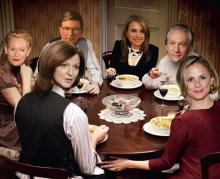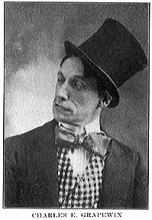The Dinner Party of my (American) Dreams
I was asked the question, “If you could invite anybody to a dinner party, who would it be?” the other day. My answer was stupid then, but it got me thinking about a hypothetical dinner party between fiveAmerican icons. It would be a crazy time because America is and was so different for them. Here’s my fictionalized account of a dinner party between filmmakers John Waters and (racist) D.W. Griffith, architect Frank Lloyd Wright, Samuel Clemens and conservative writer Norman Podhoretz, all thinking about what America means to them:
John Waters began. “My America is full of filth, debauchery, the loss of innocence, suburban life, drugs, queers, bodily waste, abortion, and religion.”
At this statement, D.W. Griffith passed out and Frank Lloyd Wright looked as if he might punch Waters in the face. Still, Waters continued.
“My America is full of trash. After all, they don’t call me ‘The Pope of Trash,’ for no reason. I see these Americans—these rich people, these conservative people, these straight people—and I’ve just gotta shock them out of their complacency. I show them that America isn’t just people like them—these WASPs—but there are gay people, drag queens, fat girls, criminals—and they’re America too. And they’re goddamn funny.”
He finished his speech and took a sip of wine. The others had uniform looks of horror and confusion on their faces.
“John is a liberal, perhaps even a flaming liberal,” said Podhoretz, disdain dripping from his lips, “I used to be one of those back in the 1960s—I even joined the socialist party with my sister--but then, like my co-founder of the neoconservative movement Irving Kristol stated, I became ‘a liberal mugged by reality’ and I moved to the right. My America is a cosmopolitan America—more people than just WASPs can be Americans-- on that I agree with John—all immigrants should be taken in as Americans, they shouldn’t be defined by their culture.”
“This idea of miscegenation and a post-ethnic America makes me sick!” Griffith interjected, “The Aryan race is the natural leader of the rest of the races and we need to protect the natural superiority of the Aryan race. This superiority and guidance of the Aryan race is what makes America! I don’t believe in slavery—I came out against it in my next film after Birth of a Nation, entitled Intolerance. But black people are naturally so violent and riotous—they disrupted the Reconstruction of the South after the Civil War!”
“I agree in a necessarily elitism in America,” said Frank Lloyd Wright, “but those ‘uncommon men’ should be decided upon because they are the smartest and most innovative of the bunch,” he said putting his hand on his chest to indicate he himself was one of these ‘uncommon men,’ “and I always build houses for these extraordinary Americans. Listen, if it was necessary for America to pick between freedom and equality—it should definitely pick freedom, because is equality even something that we would want? Some men are just better than others!”
“Then why did you make so many houses that leave no room for socializing? There is abundant room for the family to interact—but don’t they have any friends? And isn’t being part of a community—no matter how screwed up—part of the American ideal, too?” asked Waters.
“My American is non-communal, just like I am a non-communal person. My homes are family homes. Besides, individuals went to the west to be individuals and my American west is my America. Also, buddy, I am a genius so I did what I wanted, and what I wanted was family homes.”
“So let me get this straight,” said Samuel Clemens, “Your America, John, is full of a fringe culture of counterculture characters, your America, Norman, is all about race relations and war, your America, D.W., is about white supremacy and innovation, and your America, Frank, is about elitism and architecture? Am I correct in my assumptions?”
“Yes, I ‘spose you’re probably right. You always were good about summing up whole ideas in a few sentences,” said Griffiths.
“Thank you, son,” said Samuel.
“Well, ye sage father of American literature, tell us your almighty vision of America,” said Waters.
“I don’t say it myself, but others did, but Huck Finn is the quintessential American hero and The Adventures of Huck Finn is the American myth. My idea of American in the 1830s is in there, and now, Huck Finn is the poster boy for the American ideal. In Huck Finn, like in America, individuals are individuals—Huck just wants to be left alone a lot of the time-- and no matter how much they want to be alone, they still are part of a larger community and they have to contribute to it. You D.W. are in a long line of white supremacists, who were stupid and poor, and just hated black people just because they were the only ones they could pick on—just look at Huck’s father. Dumb as a fence post. America is a place where its citizens can place hope in technology and innovation—I did with my investments in science and inventions, just look where that got me, oh well—just like they were hopeful for the industrial revolution in the 1830s when my book took place. You can invent an identity in America—at least you could then—Huck often put on an untrue identity, even with his best buddy Tom, so, in America, you can be anyone you want to be, but does anybody really know anybody else?”
“So what did we really learn about America, asking this question?” asked the white-haired writer, taking a sip of his wine, and wondering why he saw a Starbucks sign out both the window to his left and to his right.
“A whole lot of nothing,” said Wright, bitter as always, “except that I shouldn’t have listened to your views, you should have listened to mine, and it’s about time that I found a new lady friend.”
“I don’t know, maybe we’ve learned the only thing that’s constant about American culture is that each American has a different one. Cultures can blend and merge, you can hate some peoples’ ideas of America, love others, hate the government, love the government, make your own culture, hate your own culture—and maybe all of those blends and new cultural ideas is America. As unsolid as that is—maybe that’s all we’ve got,” said Podhoretz.
And on the shaky foundations of five versions of America throughout three centuries, the visions of the dead Americans vanished. John Waters and Norman Podhoretz wondered how they had stayed in the same room for such a long time together, hallucinating about the Americas of three dead men. Norman said his hasty goodbyes to John— suddenly worried what GWB would think-- while John finished his wine, worshipped his shrine to Divine, and went to bed.



